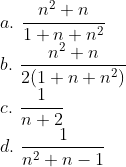Tricks To Solve JEE Main Maths MCQs Within Seconds
We all are familiar with Multiple Choice Questions (MCQs). These are the questions which give us some options, usually 4, out of which one, or sometimes more than one, is correct. The Joint Entrance Examination Main, or JEE Main, has 30 Questions per subject out of which 20 are MCQs with only one correct option. Generally in mathematics for some questions, you will find the options in integer values like chapters trigonometry, sequence and series and others for which you can easily get the answer by using the values given in options directly to solve questions and verify it in less time. In this article, we are going to explain some ticks and trips with the help of examples which you can implement in various questions. Let us understand the trick with the help of some examples.

Example 1
If A + B = 45°, then find the value of  equals
equals
a)1
b)0
c)2
d)1
Let us first try to understand the question. It means that if A + B = 45°, then the value of  is always constant, which is equal to one of the options. So, for all combinations of angles A and B whose sum is 45°, the value of (
is always constant, which is equal to one of the options. So, for all combinations of angles A and B whose sum is 45°, the value of ( will always be the same, which is equal to one of the four options.
will always be the same, which is equal to one of the four options.
So, whether (A = 0° and B = 45°) or (A = 1 ° and B = 44°) or (A = 10° and B = 35°), they all will give the same value of (1+tanA)(1+tanB). So, we can easily replace A and B with some convenient values of angles and get the required value of (1+tanA) * (1+tanB). Let us put A = 0° and B = 45°,
 = (1+tan0°)(1+tan45°) = (1 + 0)(1 + 1) = 1*2 = 2
= (1+tan0°)(1+tan45°) = (1 + 0)(1 + 1) = 1*2 = 2
So, option C is correct
Example 2


Now we have to select the option that gives the correct sum for all natural number values of n. So, the correct option has to be true for n = 1, 2, 3, …and all other natural number values of n. So, if any option is giving the wrong sum for n = 1, we can be sure that that option is incorrect.
Also Read,
- Science Olympiads: How To Plan For Competitive Exams
- 5 Apps To Help You Avoid Distractions, Become More Productive
- Identifying Signs Of Learning Disability And Getting A Diagnosis
Let us try to find the options that are incorrect.
For n = 1, the actual sum of the given series is  =
= 
Checking what value option A for n = 1:  . So, it gives the wrong answer for n = 1, and hence it cannot give the correct answer for all values of n. Hence this option is wrong.
. So, it gives the wrong answer for n = 1, and hence it cannot give the correct answer for all values of n. Hence this option is wrong.
Checking what value option B for n = 1: ( . So, it gives the correct answer for n = 1. But this might give wrong answers for higher values of n. So, we will not mark this as correct right now.
. So, it gives the correct answer for n = 1. But this might give wrong answers for higher values of n. So, we will not mark this as correct right now.
Checking what value option C for n = 1:  So, it gives the correct answer for n = 1. But this might give wrong answers for higher values of n. So, we will not mark this as correct right now.
So, it gives the correct answer for n = 1. But this might give wrong answers for higher values of n. So, we will not mark this as correct right now.
Checking what value option D for n = 1:  So, it gives the wrong answer for n = 1, and hence it cannot give the correct answer for all values of n. Hence this option is wrong.
So, it gives the wrong answer for n = 1, and hence it cannot give the correct answer for all values of n. Hence this option is wrong.
Now both options A and D are eliminated, and one of option B or C is correct. Let us now see which of these two is giving the correct answer for n = 2.
For n = 2, the actual sum of the given series is

Checking what value option B for n = 2:  . So, it gives the correct answer for n = 2 as well. But this might give wrong answers for higher values of n. So, we will not mark this as correct right now.
. So, it gives the correct answer for n = 2 as well. But this might give wrong answers for higher values of n. So, we will not mark this as correct right now.
Checking what value option C for n = 2:  . So, it gives the wrong answer for n = 2, and hence it cannot give the correct answer for all values of n. Hence this option is wrong.
. So, it gives the wrong answer for n = 2, and hence it cannot give the correct answer for all values of n. Hence this option is wrong.
Now we know that 3 out of 4 options are wrong, and only option B is left. So, we can safely mark option B as correct.
Example 3

If the value of the determinant given equals ka3b3c3, then the value of k is
a)1
b)0
c)-1
d)2
This question means that the value of the determinant always equals ka3b3c3 for all sets of values of a, b and c. In such questions, we can substitute some values of a, b and c and check to see the values of the determinant and the value of ka3b3c3. Also try to keep values of a, b and c such that ka3b3c3 does not become 0. So we will keep non-zero values of a, b and c. Let us put a = b = c = 1.
The value of the determinant is

which equals 0 (As two columns are the same) and the value of ka3b3c3 is k. So comparing these, we get k = 0.
Know when to use this trick and when not to. Don't use it for questions with more than one right answer or for multiple-choice questions where 'None of these' or 'All of these' is the only correct option.
Popular Courses and Specializations
List of colleges accepting JEE Main
Browse Engineering Colleges by State
Questions related to JEE Main
On Question asked by student community
Hello,
Since the NTA conducts exams in Tamil, these official papers will have a Tamil language option. Kindly check the following link to get the question papers.
https://engineering.careers360.com/articles/jee-main-question-papers
I hope this helps you.
Hello there,
Understanding and solving different question papers is one of the best practice for the preparation specially when it comes to JEE mains. It gives you proper understanding of the exam pattern, important topics to cover and marking scheme.
Here is the link attached from the official website of Careers360 which will provide you with the link of previous year question papers on chemistry in PDF format. Hope it helps!
https://engineering.careers360.com/articles/jee-mains-chemistry-questions-in-last-year-exam-premium
thank you!
Hello,
Yes, you can be eligible , but it depends on how you passed Mathematics.
JEE Main
You are eligible if:
-
You passed Class 12 with Physics and Mathematics.
-
Mathematics was passed as a full subject from NIOS.
-
NIOS is a recognized board.
-
Having two marksheets is allowed.
You are not eligible if:
-
Mathematics was taken only as an improvement or additional without passing it as a full subject.
MHT-CET
You are eligible if:
-
You passed Class 12 with Physics and Mathematics.
-
Mathematics from NIOS is shown as a passed subject.
-
NIOS is recognized for Maharashtra admissions.
-
Mathematics was passed before the admission year.
You are not eligible if:
-
Mathematics is not shown as a passed subject.
Important
-
Mathematics must be a separate and passed subject.
-
Keep both marksheets during counselling.
Always check the current year information brochure before applying.
Hope it helps !
The marks needed for a 99+ percentile in the JEE Main January attempt depend on the difficulty of the paper and the total number of candidates. Generally, you need roughly *180–200* marks out of 300 to hit the 99+ percentile. The exact cutoff varies each session, so checking the official NTA percentile score calculator or previous year cutoffs gives a more precise idea.
Hello aspirant
JEE Main accepts NIOS, so you can appear if you meet the basic eligibility.
BITS does not accept marks from two different boards, so this option won’t work for BITS.
VIT and SRM generally accept NIOS, but having two separate mark sheets can be an issue. You should check their official eligibility rules before applying.
Thankyou I hope this help
B.Tech/B.Arch Admissions OPEN
Among top 100 Universities Globally in the Times Higher Education (THE) Interdisciplinary Science Rankings 2026
UPES B.Tech Admissions 2026
ApplyRanked #43 among Engineering colleges in India by NIRF | Highest Package 1.3 CR , 100% Placements
Jain University B.Tech Admissions 2026
Apply100% Placement Record | Highest CTC 54 LPA | NAAC A++ Accredited | Ranked #62 in India by NIRF Ranking 2025 | JEE & JET Scores Accepted
VIT - VITEEE 2026
ApplyNational level exam conducted by VIT University, Vellore | Ranked #16 by NIRF for Engg. | NAAC A++ Accredited
M. S. Ramaiah University B.Tech Admissions 2026
ApplyNAAC A+ & NBA Accredited | QS I-Gauge Gold rated University | Highest CTC 52 LPA | 300+ Companies | Avail Scholarships Application Deadline: 28th Feb’26
Amrita University B.Tech 2026
ApplyRecognized as Institute of Eminence by Govt. of India | NAAC ‘A++’ Grade | Upto 75% Scholarships
